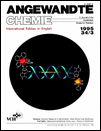Electron Transfer through DNA: Site-Specific Modification of Duplex DNA with Ruthenium Donors and Acceptors†
This research was supported by the Donors of the Petroleum Research Fund, administered by the American Chemical Society, the Research Corporation, and the Biological Imaging Center of the Beckman Institute. The authors thank Harry Gray, Jay Winkler, I-Jy Chang, and Robert Kaiser for helpful discussions.
Abstract
The rate of the electron transfer between two ruthenium centers at the ends of an octanucleotide duplex (metal-to-metal distance = 21 Å) was determined to be 1.6(4) × 106 s−1. By using automated DNA synthesis techniques, modified oligonucleotides were prepared with a protected phosphoroamidite of 2′-amino-2′-deoxyuridine. The NH2-modified oligonucleotides were hybridized with complementary DNA sequences to protect nucleotide bases, and then treated with ruthenium complexes. In this way the ruthenium complex was bound only to the free NH2 group.




